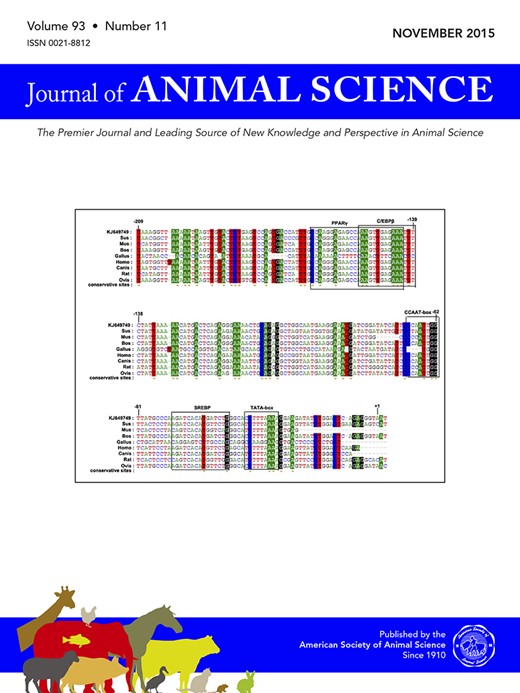-
Views
-
Cite
Cite
D. N. Black, B. W. Neville, M. R. Crosswhite, C. R. Dahlen, Evaluation of implant strategies in Angus-sired steers with high or low genetic potential for marbling and gain, Journal of Animal Science, Volume 93, Issue 11, November 2015, Pages 5411–5418, https://doi.org/10.2527/jas.2015-9296
Close - Share Icon Share
ABSTRACT
Sixty-nine Angus-sired steer calves (332.3 kg initial BW) were used to determine the effects of single or double implant strategies on steers of high or low genetic potential (GP) determined by the GeneMax (Zoetis, Florham Park, NJ) genetic profiling test. Steers were assigned to treatments in a 2 × 2 factorial design with factors of 1) composite GP score (high, mean GP score of 86.5 [HI]; low, mean GP score of 25.3[LO]) and 2) implant strategy (single, steers implanted on d 70 [1X], or double, steers implanted d 0 and 70 [2X]). All steers were given the same implant (Revalor-S; Merck Animal Health, Summit, NJ), with the 2X group implanted on d 0 and 70 and the 1X group implanted only on d 70. A diet containing 1.38 Mcal NEg/kg DM was fed ad libitum, once daily. Ultrasound was used to measure body composition characteristics on d 0 and 70. Steers were harvested after 140 d on feed. At both the d-0 and d-70 ultrasound, HI steers had greater (P < 0.001) percent intramuscular fat (IMF) than LO steers, but no differences (P ≥ 0.24) were observed in LM area (LMA), rib fat thickness (RF), or rump fat thickness (RMFT). Steers in the 2X group had larger (P = 0.02) LMA and less (P = 0.03) IMF on d 70 than 1X steers and no differences (P ≥ 0.50) in RF or RMFT were observed. From d 0 to 70, HI steers had ADG, DMI, and G:F (P ≥ 0.60) similar to LO steers; however, 2X steers had greater (P < 0.001) ADG and were more (P < 0.001) feed efficient compared with 1X steers during the same interval. Over the entire 140-d feeding period, there were no differences (P ≥ 0.6) in BW, ADG, DMI, or G:F between GP groups; however, 2X steers had greater (P = 0.03) ADG compared with 1X steers and still had similar (P ≥ 0.12) DMI and G:F. Upon slaughter, marbling score tended to be impacted by a GP × implant interaction (499.9 ± 18.5, 545.6 ± 18.5, 487.1 ± 18.5, and 469.8 ± 18.5 for HI and 2X, HI and 1X, LO and 2X, and LO and 1X, respectively; P = 0.06). No differences (P ≥ 0.7) were observed between GP groups for HCW, LMA, RF, KPH, or yield grade (YG). Steers in the 1X group had less (P = 0.003) RF than 2X steers but similar (P ≥ 0.14) HCW, marbling, LMA, KPH, and YG. A greater proportion (P = 0.03) of HI steers had choice carcasses (100 ± 0.0%) compared with LO steers (87.8 ± 3.9%). Results of this study indicate that the GP test used in the current study predicted differences in IMF, carcass marbling, and percent carcasses graded as choice.





